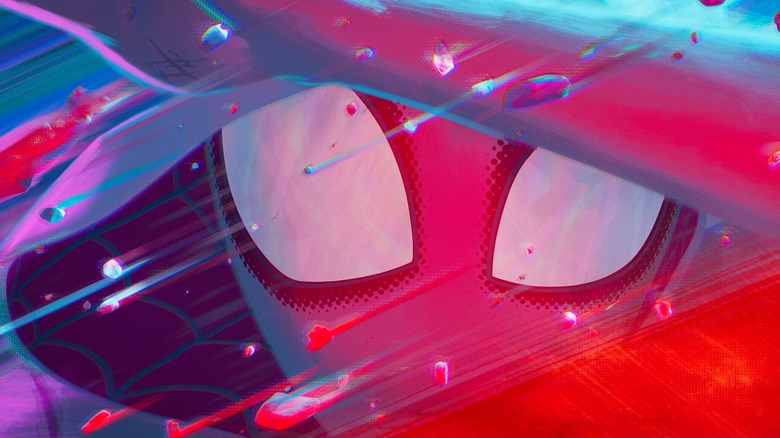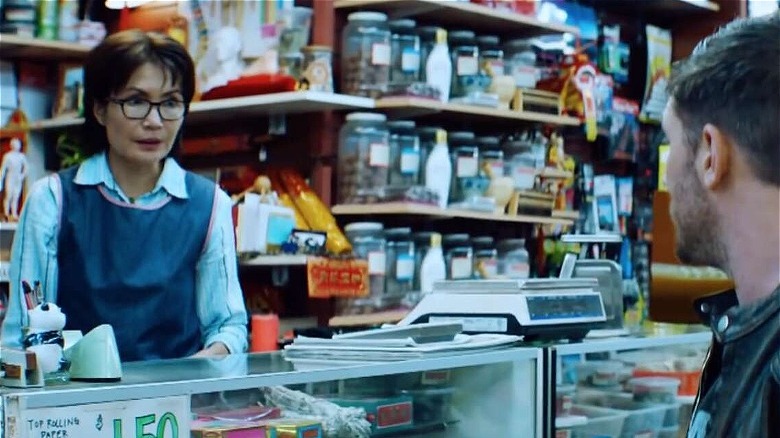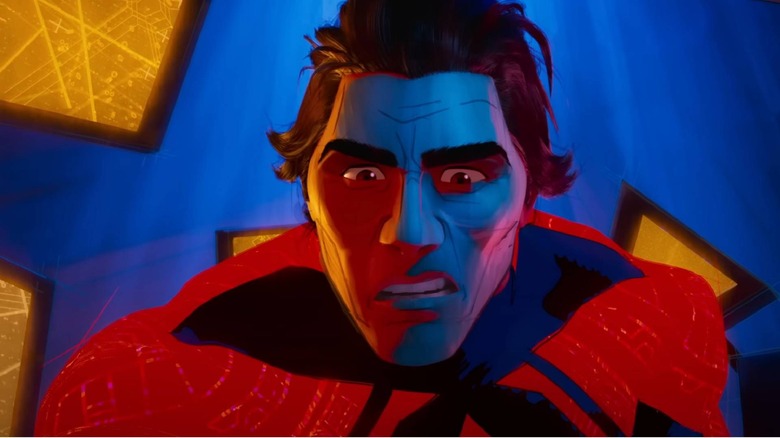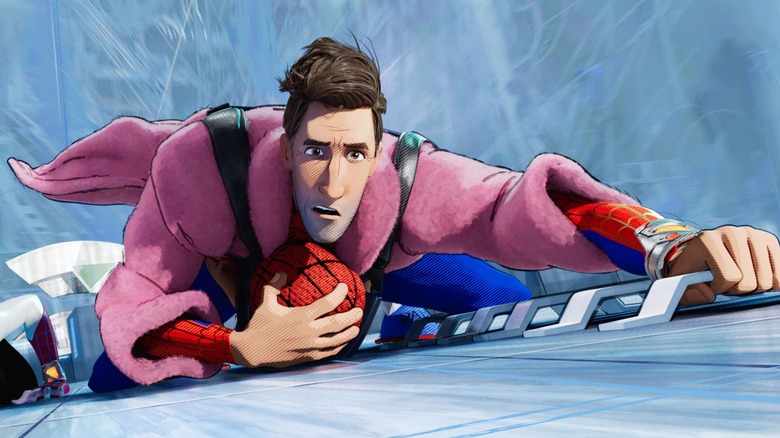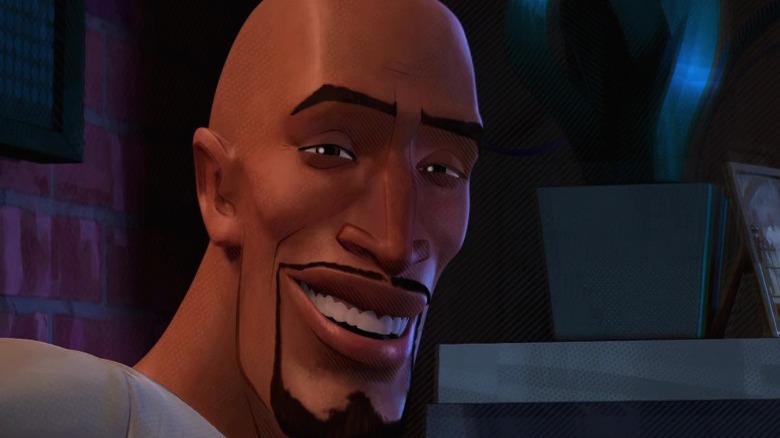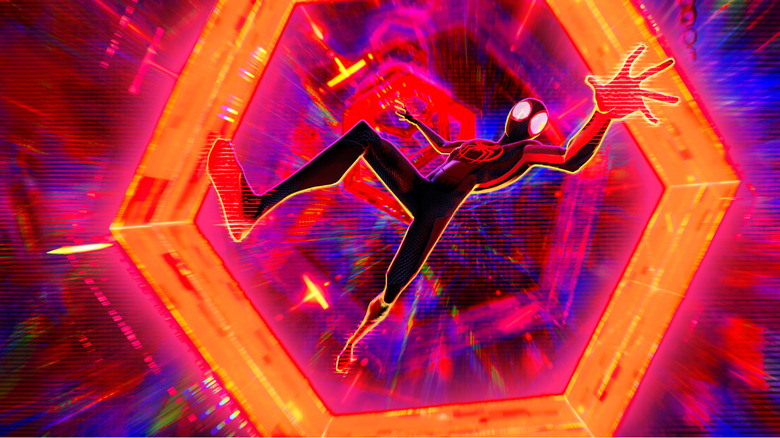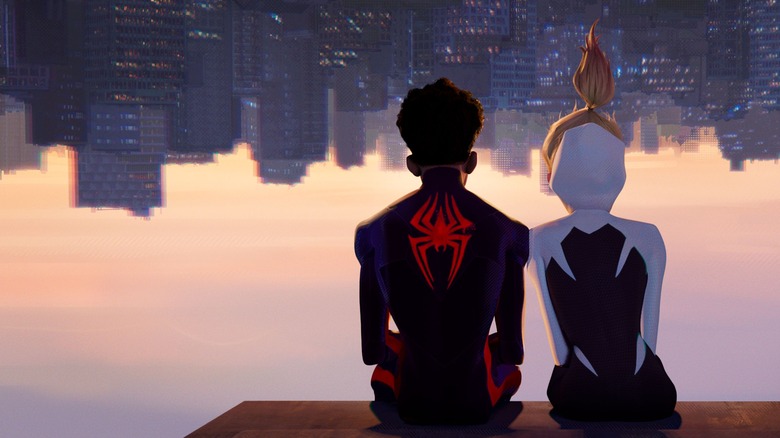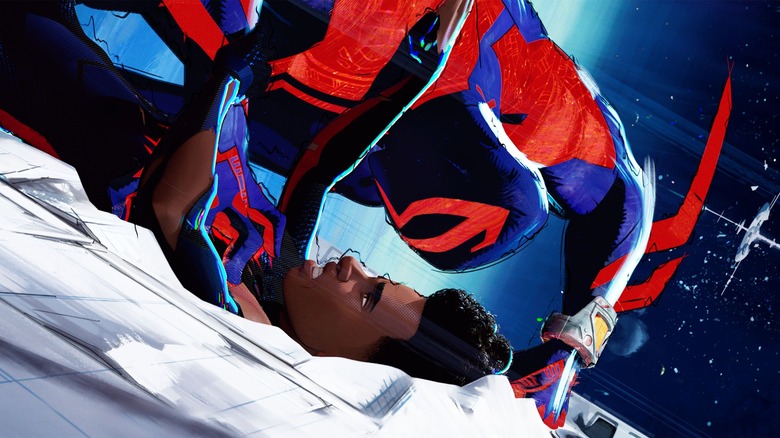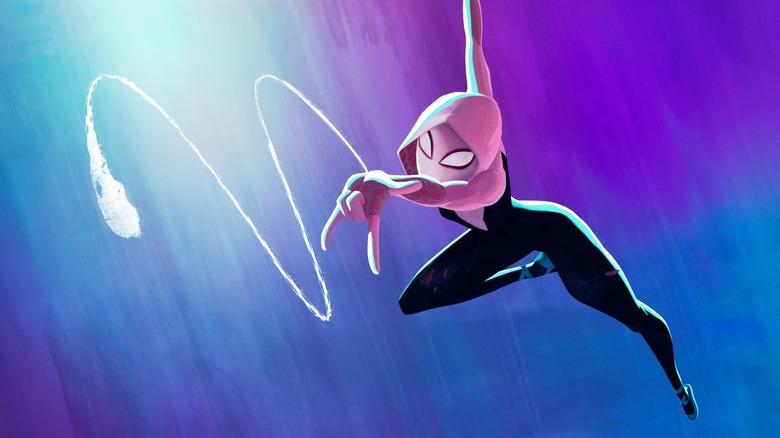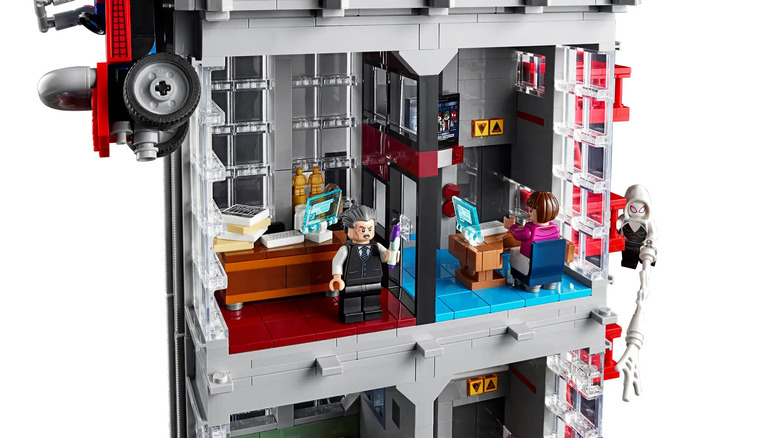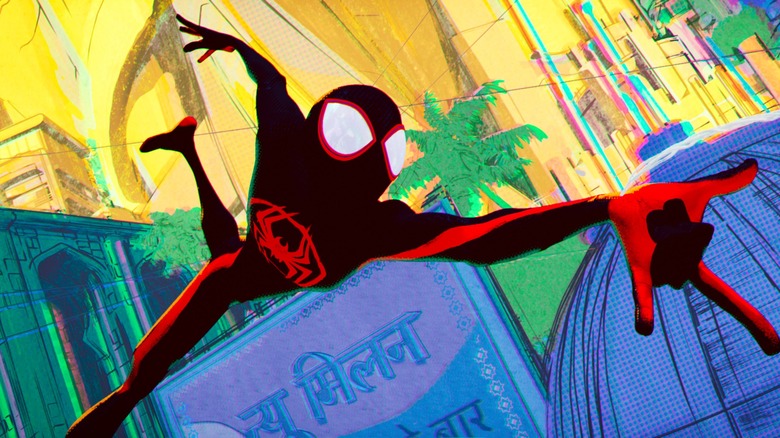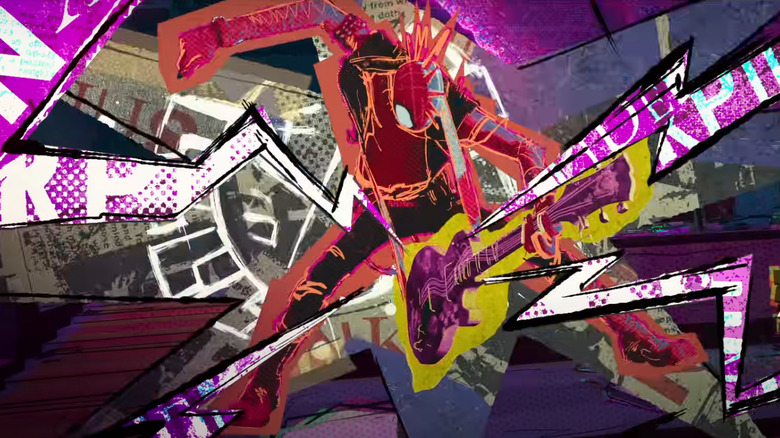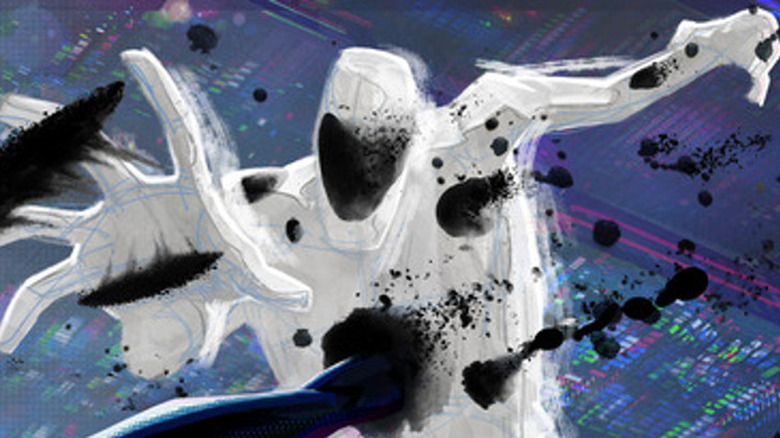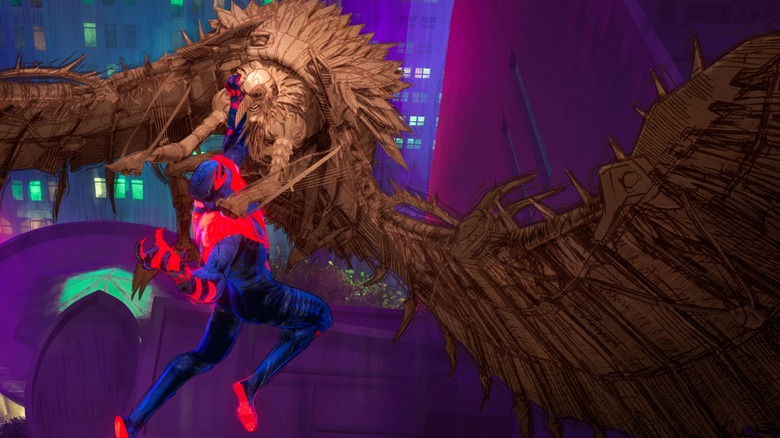Every Dimension Visited By Major Characters In Spider-Man: Across The Spider-Verse, Ranked
The following post contains spoilers for "Spider-Man: Across the Spider-Verse."
In 2018's "Spider-Man: Into the Spider-Verse," different spider-powered individuals and villains from other dimensions converged on New York — and also on the life of the newest Spider-Man, Miles Morales (Shameik Moore). In the long-awaited sequel, "Spider-Man: Across the Spider-Verse," Miles travels to some of those dimensions, and he's not the only one. Other major characters, like new villain The Spot (Jason Schwartzman), returning heroine Gwen Stacy (Hailee Steinfeld) and dubious ally Miguel O'Hara (Oscar Isaac) do their share of multiverse tripping as well.
Several universes are seen onscreen, including some only glimpsed through portals. We're ranking the ones that primary characters actually set foot — or head, or arm — in. If they do so only in flashback, that counts. From worlds inspired by one small change to others with wholly different aesthetics and physics, here are the 13 dimensions visited by significant "Across the Spider-Verse" characters, ranked worst to best. Again, be warned that MAJOR SPOILERS follow.
13. Sony's Venomverse
Literally, only one thing in the Sony Venomverse generates interest: Tom Hardy. His twitchy pseudo-Marlon Brando Method acting as Eddie Brock and jealous psychotic-lover take on the Venom symbiote made an otherwise formulaic script come to life. It was as if Hardy stumbled into a '90s superhero movie and decided to sabotage it, turning the dark and tormented antihero into a one-man, two-souls gay romantic comedy with a body count.
So to visit the Venomverse and not encounter Eddie Brock feels like a bit of a waste. Without him, it's just an extra-dark San Francisco where some people say "Sym-BUY-ote" instead of "symbiote." Yeah, we get that The Spot has a thing for convenience stores, and the gag is he pops into Mrs. Chen's, where he's not particularly weird compared to regular customer Eddie/Venom. No doubt Tom Hardy floated beyond the realm of budgetary possibility. What about Venom, though? He couldn't pop in even as a reflection or something?
12. Miguel's Replacement Universe
The universe Miguel O'Hara (Oscar Isaac) entered to replace a dead variant of himself is wildly inconsistent onscreen. In his personal photos, it looks just like his current world, on a sunny day. In his initial retelling, it resembles '80s comic-book panels. Then, as he recounts its end, it mostly just looks like a bunch of disappearing buildings, without much time to get a sense of how they're visually different. They don't seem particularly 2099-ish, though.
It's a significant universe to the plot, because it provides the origin of Miguel in his current driven, edgelord incarnation. Aesthetically, however, it seems to be whatever he remembers it as at any given moment, and because he's slightly nuts, that's not a consistent picture. Nor is it remotely as awesome in appearance as his current digs. Hell, it's hard to imagine anyone that lived there was interesting enough to kill him once. Maybe he secretly died of boredom.
11. Peter B. Parker's Earth
Peter B. Parker (Jake Johnson) was entertaining in the first "Spider-Verse" movie because of his sadness. A middle-aged, beer-bellied Spider-Man who served as dubious mentor to Miles, he had divorced his MJ over their differing opinions regarding children. After regaining his spark, he decided to try again, and while it's good for him that he's now happily married with a kid, he delivers a lot less entertainment. Still, the sheer recklessness with which he gives baby Mayday web shooters, and takes her into fights with him — that part's funny. His Earth, though, just looks like a nice, calm suburban neighborhood.
What makes it cool is what happens in it at the very end of the movie. Gwen assembles her own team, and in it we see Spider-Ham and Spider-Man Noir. As of this writing, there's no official word on whether John Mulaney and Nicolas Cage will be back. This is the multiverse, after all, and recasting comes with the plot. At least we get their characters back, as they're sorely missed in a sequel that's overall lower on major comedy characters, except for small cameos.
10. Earth-42
Forty-two, as most sci-fi fans know, is the answer to the question of life, the universe, and everything. For Miles Morales, it specifically is the universe that's the source of the spider which bit him. It was meant for that Earth's Miles, who wound up becoming the Prowler instead, in league with his still-living Uncle Aaron (Mahershala Ali). Like Sony's live-action Venom and Morbius movies thus far, Earth-42 is a world without a spider hero, though it has suffered all the more for it. Half the city looks to be on fire, like the stylized Detroit of "The Crow." The buildings mostly look the shade of dark purple common to comic-book villains like the Joker, Skeletor, or Green Goblin. And don't forget Prowler Miles' apartment, which boasts its own torture dungeon.
What we see of this potential villain-verse intrigues us. So far it seems way cooler than "Morbius," but then again, what doesn't?
9. The Universe-Wide Web
Does the dimension between dimensions count? It seems like it must, as stuff definitely happens there. Like in the "Bill & Ted" movies, the inter-dimensional spider-travelers appear to use a series of long, twisty passages through an alternate space. As in "Guardians of the Galaxy," hexagons indicated the warp tunnels. In what may be a weird nod to the classic British nuclear war movie "Threads," the whole shebang is referred to as a web of people connected by threads. "Threads" borrowed its title from the whole idea of a spider web, in part because the original Internet, which delivers the World Wide Web, was designed to maintain communications during a nuclear war. So it all whips back around — mess with this web at the threads, and existential catastrophe could ensue.
Consider for a moment, though, an alternate, metaphorical meaning. As Miguel O'Hara's Spider-Society obsessively monitors this web for what they call breaks in canon, they resemble excessively online incel fans scanning the World Wide Web for word of Spider-Man stories that dare go in different directions they disapprove of, like having Spider-Man be a young Black-Latino man named Miles Morales instead of Peter Parker.
8. Earth-1610 - Miles' New York
Miles' New York still sets the standard by which everywhere else in the Spider-Verse is measured. There are some changes this time — fewer speech balloons, and much more blurry "misprinting" on the backgrounds. Think of it as a comic book brought to life, with all the printed dots and four-color effects seen on the page. Because Miles is the protagonist, and a graffiti artist, his world sometimes switches to his point of view, and becomes an animated version of the sketches in his art book. Then, when the Spot narrates, sometimes it becomes black and white line drawings. As the "prime" universe in Miles' story, it's the one that has the freedom to get messed with the most, since viewers are used to its style now.
With both Gwen and Miles fond of ignoring gravity, they get to experience the city from all angles, walking sideways and upside down across its ghosting buildings. It's a lesson in looking at the familiar (like Spider-Man) from new perspectives.
7. Earth-928 - Nueva York
Earth-928 isn't just awesome because all the dimension-hopping Spideys hang out there, but it surely ranks as a major reason, giving the scenes here the most sight gags and cameos. Once the movie arrives on Blu-ray, thumbs will get a workout hitting pause and frame-by-framing.
That aside, Nueva York still looks like a fun place to be, with its eco-topian skyscrapers surrounded by green fields, and space elevators that send trains to the moon. That's during the day. At night, it becomes "Tron" meets "Blade Runner," minus the AI trying to kill you at every turn. Miguel presents as intelligent, yes, but hardly artificial. Without him, this year 2099 seems idyllic, especially since, due to Disney copyrights, we know good and well that it can't have Punisher 2099, Ghost Rider 2099, or Hulk 2099 lurking anywhere in the shadows to ruin your week.
Anyone without web-slinging abilities might want to look out for all the dangerous ways to fall from great heights, though.
6. Earth-65 - Gwen's New York
Gwen Stacy's Earth uses a palette typically associated with stereotypical "girl comic" colors — light blues, purples, and pinks, as seen in titles like "Jessica Jones" and "Gwenpool." It's applied in the style of someone like Bill Sienkiewicz — broad brush strokes over 3D models, painting the world in watercolor. Adding to the effect, every time a character gets emotional, the paint in the background starts to drip and run, like the whole world cries with them.
At times, the characters here feel a little static and less fluid than in other realities. When Gwen plays her drums, however, the entire environment vibrates and vibes with her. Yet it's also imbued with melancholy: a dead best friend, a distant dad, and the memory of a potential love interest she must stay away from. It's like an entire world based on the "Blade Runner" concept of tears in the rain. As distant as Gwen gets from it, though, we have a feeling she won't allow it to disappear.
5. Earth-13122 - The LEGO-verse
As depicted here, the LEGO Spider-Man universe is basically just one set: The Daily Bugle, available to purchase for a mere $349.99. It's a tribute to producers Chris Miller and Phil Lord, who also made "The LEGO Movie." Is it the same universe as their movies? Legally, probably not — Warner Bros. owns the existing LEGO movies, while Universal owns any future ones, and when it involves superheroes, they've been strictly Team DC thus far.
However, the fact that LEGO Peter Parker makes his own sound effects suggests that, like in "The LEGO Movie," someone larger is playing with toys to create this world. What it doesn't explain is one of the movie's best running gags: that J. Jonah Jameson appears to be played by J.K. Simmons in every universe. Unless the kid playing with the set is Jameson's kid, or just does a really good Simmons impersonation.
4. Earth-50101 - Mumbattan
Okay, it's a little weird that the film depicts "India" and "New York" as completely different planets, when they both exist on the same one in real life. The twist of a skyscraper-heavy "New York" in India, though, is pretty cool, and that's even before dealing with the art style, which features plenty of unfinished pencils and outlines, with judicious inking and captioning as needed. In a weirder twist, we learn that even though India apparently dominates this world, it also still has a past under colonialism in which the British government stole many things.
This Earth comes with a bonus cultural lesson: no sensitive, aware viewer will ever say "chai tea" after watching this. Unless, of course, they're the type of people who still say "ATM machine." Because the "M" already stands for "machine," just like "chai" means "tea." Thank you, Pavitr Pravakhar, for the teachable moment.
3. Earth-138 - Punk Earth
The world from which Hobie Brown (Daniel Kaluuya) hails is as punk rock as he is; a blast of discord both aural and visual. It's reminiscent of the Sex PIstols' "Never Mind the Bollocks" album cover, and the collages on DIY fliers, with the ransom-note fonts and repurposed newsprint images. Even when Hobie's not in his home dimension, he carries an aura of it around him, like the haze of pot smoke surrounding certain hippie musicians and rappers when they emerge from their dressing rooms.
In the comics, this Earth's America is a fascist dimension ruled by a Norman Osborn variant, but so far in "Across the Spider-Verse," this Hobie appears to be from England, with his realm described mainly as a place where Gwen likes to hang out with him. Their relationship hasn't been clarified, but he loves to break rules even more than she does. Like so much punk rock, his reality is as chaotic, sloppy, and loud as it wants to be ... and we need to see much more of it in the sequel.
2. The Vintage Comics-verse
Perhaps the most inhospitable universe to the Spot is this one, in which a lady repeatedly beats him with a handbag. We'd love to see more of it, though. Seemingly based on comics of the 1930s, which predate the creation of Spider-Man, this depicts the kind of universe in which one might see the original Red Tornado, or Popeye.
It's a blast to imagine Spider-characters existing in this realm, though how they did so before Stan Lee remains a mystery. Imagine something like the Archie-Punisher crossover, but with the Phantom encountering Little Orphan Annie. Annie, of course, would possess the spider-powers in this equation, though her webs would always come out ... tomorrow. Bet your bottom dollar that tomorrow ... she'll be swung.
This is the spinoff we really need, Avi Arad. Even if it's just a five-minute cartoon, like the Spider-Ham short on the previous Blu-ray.
1. The Da Vinci-verse
The first villain Gwen encounters in the movie? A Vulture unlike any other. He looks like he's made from parchment, because he hails from a comics universe completely made up of Leonardo da Vinci-style sketches. Using those early flying machine designs, along with a healthy helping of chemistry-derived weapons in vials, he's like a version of steampunk that predates the use of steam engines. Woodpunk? Carpentrypunk?
We only get a quick glimpse of his universe, but it counts, and makes us wish for more. He's also the kind of character who only works in animation — not literally made of paper but looking like he is, which could lead to some big existential questions in live-action. When a character's universe is an actual 2-D page in a comic, what's it like for them to suddenly become a 3-D version of a torn-out page? No wonder this Vulture exudes confusion and anger.
Is it a stretch to call this Vulture a major character? He's the first-act villain, so it's our opinion that he counts, especially since he's easily the best-drawn villain onscreen.
